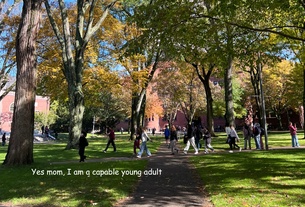{shortcode-924801678207787e69c41e4e84a2421ba0e3cf8a}
“What we want to do is to make them feel as though, given that they’re philanthropic, that Harvard is a place where they want to be philanthropic,” Rogers said. “It really is our responsibility to make them feel that out of all the different things that they could support in this country and in the world that Harvard makes a difference.”
Michael D. Smith, dean of the Faculty of Arts and Sciences and the head of its $2.5 billion campaign, echoes Rogers, explaining that tailoring the pitch to individual donors maximizes effectiveness.
“When I sit down with a donor and they say, ‘I have an ‘X’ amount of money to give, and I can give it to you or I can give it to this other very worthy charity down the street,...[I respond that] each dollar that’s given is actually going to very meaningful activities, like financial aid, like the things we’re trying to do in the Houses, and so forth,” Smith said. “And when you start explaining it like that, it’s very meaningful especially to our own alumni who have experiences here, or to parents who have children who are now experiencing what’s happening here.”
For high-wealth donors, for whom giving to charitable causes is not a zero-sum game, excitement about a cause is as important as its worthiness, administrators and philanthropy experts say, and each individual must negotiate a personal set of factors.
“You can always trump someone’s philanthropy—you can always say you should be giving your money to ‘X’ or ‘Y’ cause instead,” Schervish says. “There’s always this possibility that what you see as more important is something that other people are not inspired to give to.”
TRIED AND TRUE
If an exciting cause is necessary to get donors to the negotiating table—be it for a building, a professorship, or a scholarship fund—the decision to make a gift is ultimately based largely on confidence in the institution to carry out its objective.
Many upper-level donors view their philanthropy in terms of a “portfolio,” according to Frederick M. Hess, the director of education policy studies at the American Enterprise Institute. And these donors see Harvard as a long-term, low-risk investment compared to many other younger, more volatile causes.
“It may or not be the most exciting thing you can do—it's not a startup, it's not going to eradicate malaria,” said Richard A. Marker, the founder of New York University’s Academy for Grantmaking and Funder Education. “But in the long run...there's a very, very high likelihood that it will do something good.”
For many potential donors, Harvard’s track record of producing world-leading ideas and people, as well as its sophisticated organizational structure, indicate that the University is well-equipped to handle and use donations effectively.
“They have a plan put in place to deal with that money,” said Maria Di Mento, an assistant editor for the Chronicle of Philanthropy who covers big giving. “Large institutions know what to do with the money, they really have a plan of how to handle the money, and they can offer something that donors can see.”
Hess says that with Harvard’s celebrated faculty, for example, donors who endow a professorship do not have reason to worry. “If one professor leaves, the whole [organization] will not fall apart.”
{shortcode-4f3db92e53f33c5aa7d183a8ce785982cc237568}
Donors interviewed for this story largely agree, saying that giving to Harvard entails a perpetuation of historical excellence that relies on the reputation of the past and continues it into the future. In the same way that Faust describes Harvard’s investment perspective as “long-term,” donors often view their gifts to Harvard as long-term investments in a better world.


